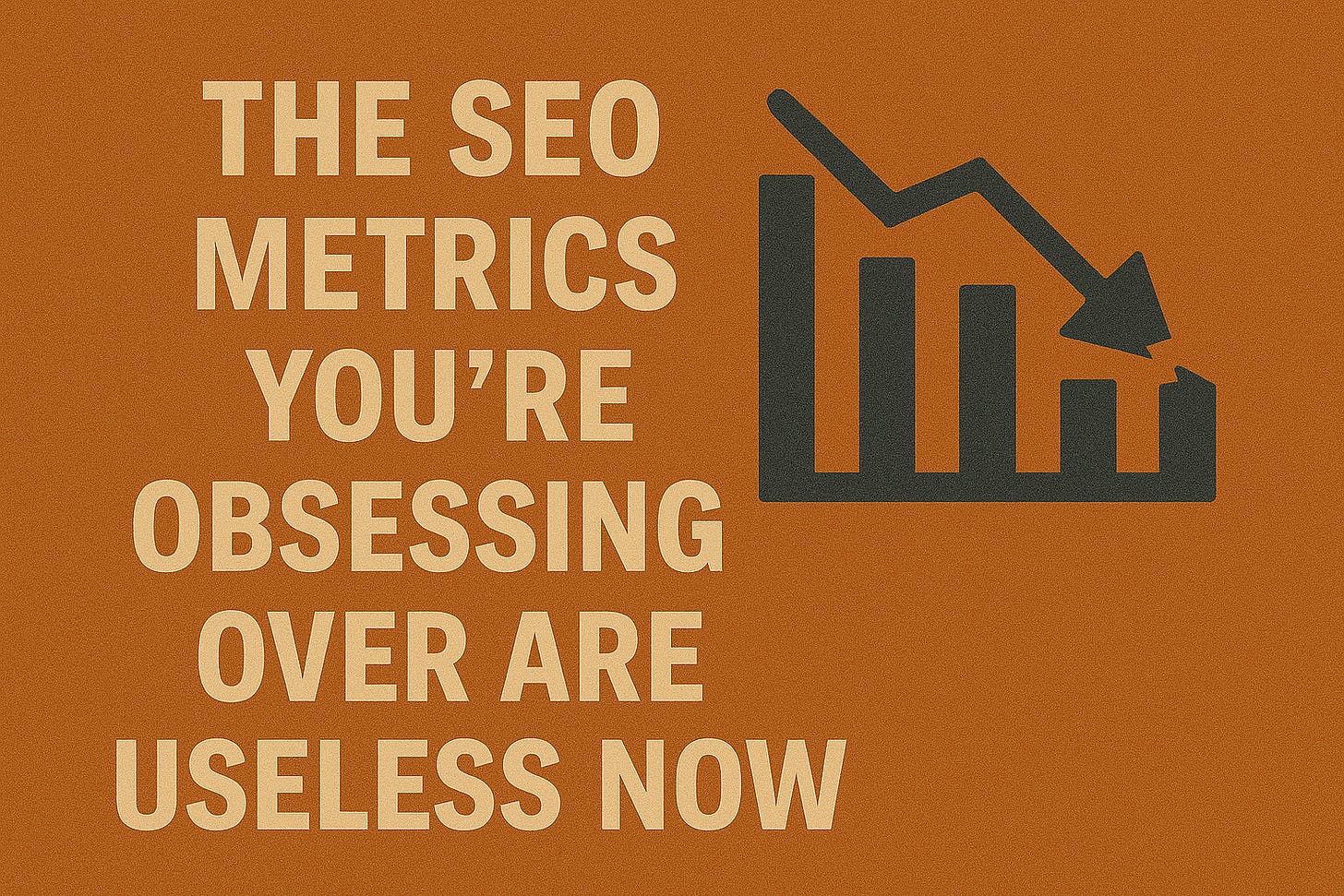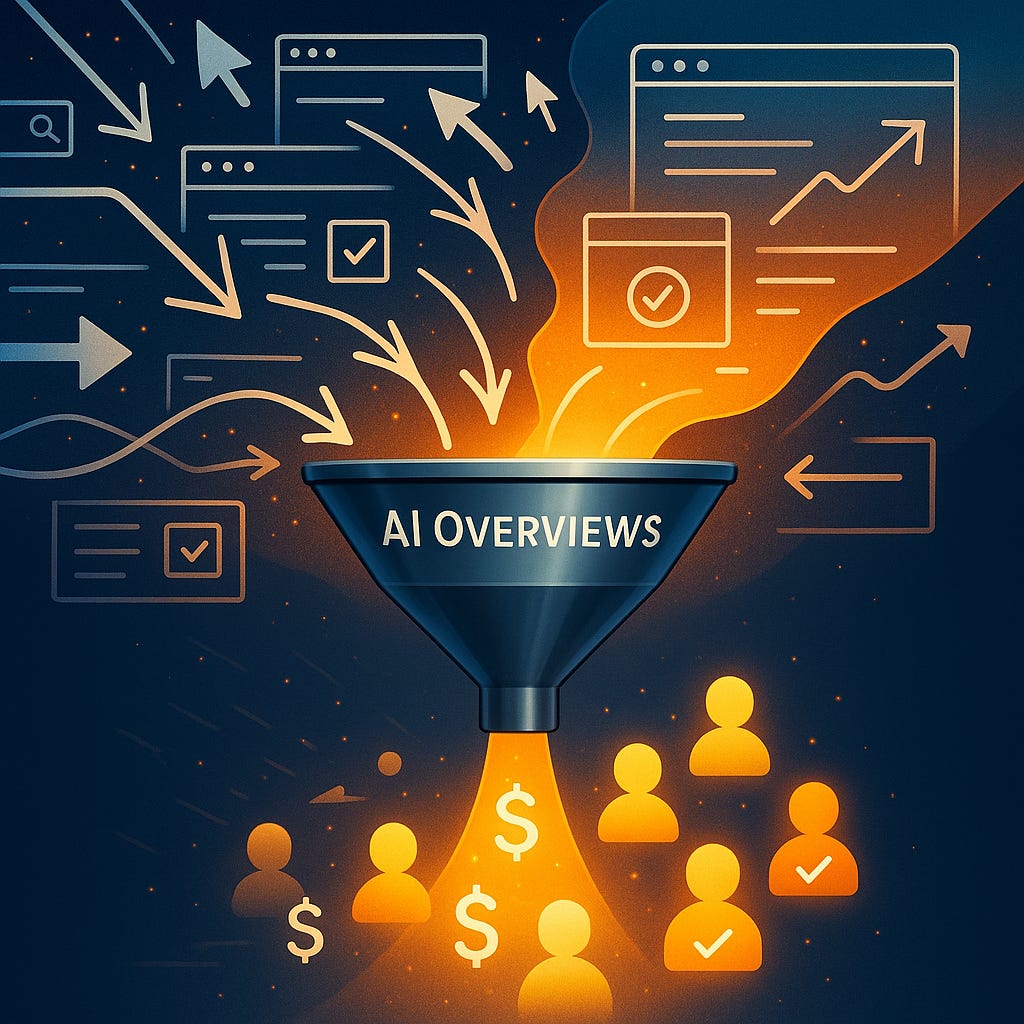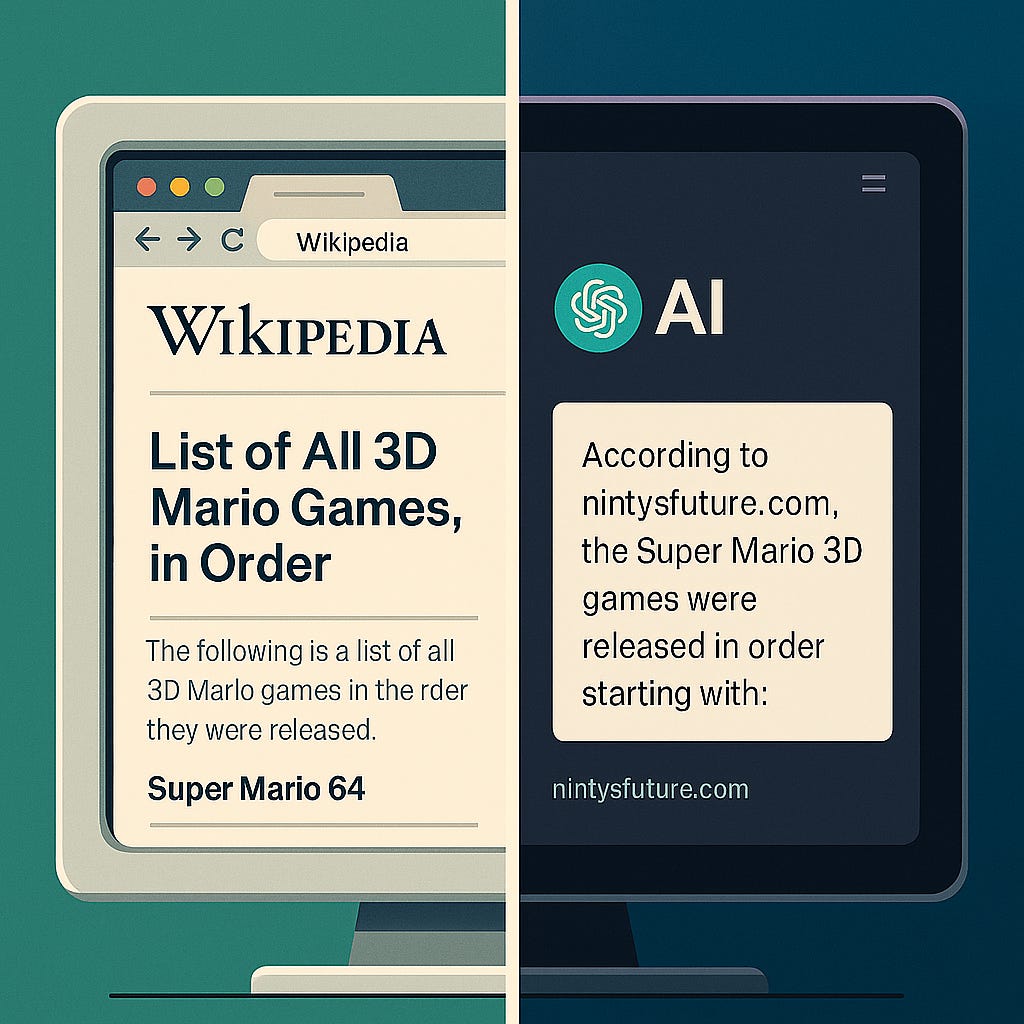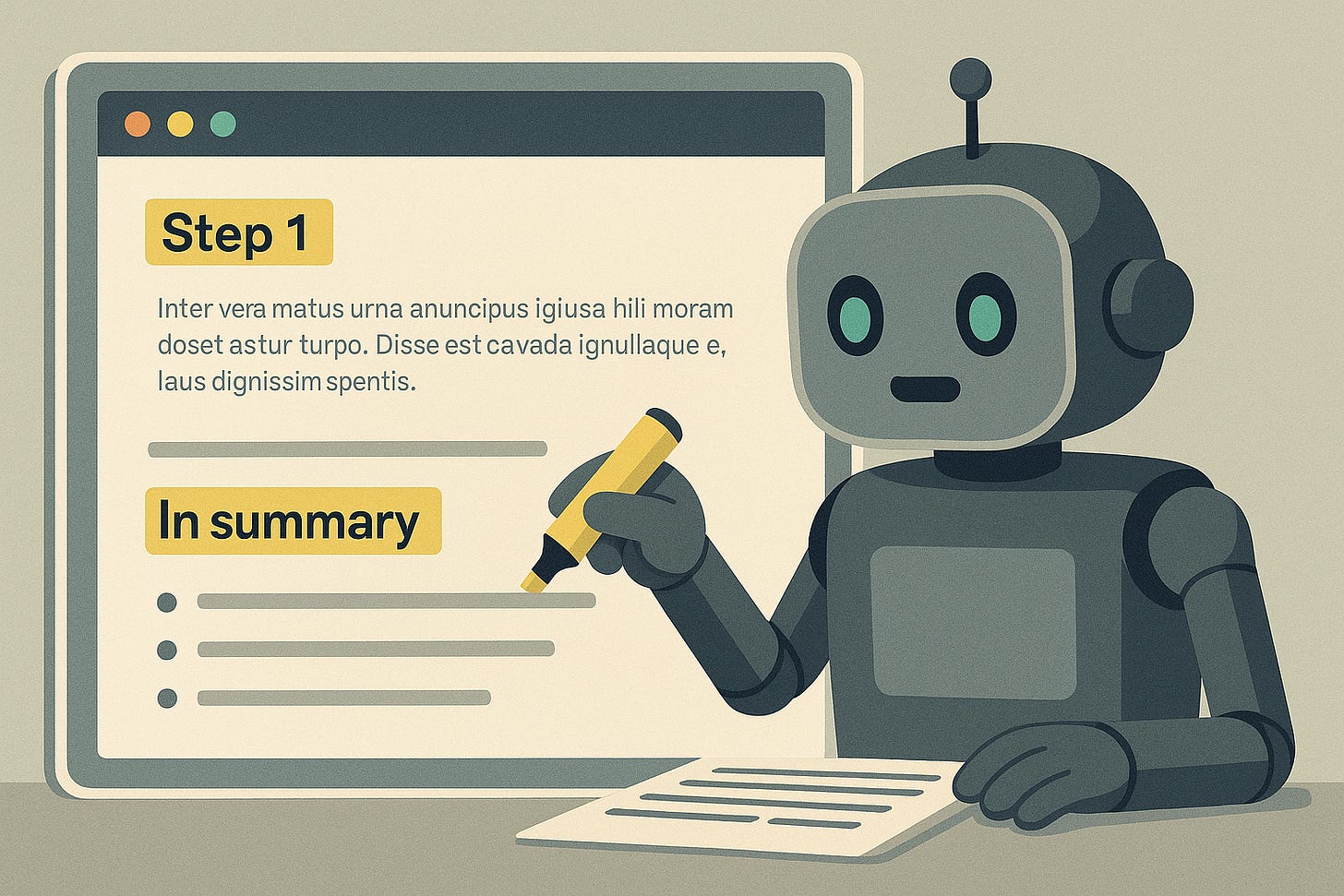The SEO Metrics You’re Obsessing Over Are Useless Now
Lesson 1, Module 3 of The AI SEO Playbook for LLMs & AI
In Module 1, we got tactical—a no-fluff checklist to fix your SEO foundations in the age of AI. We focused on what to do.
In Module 2, we zoomed out to understand how AI interprets content. We broke down semantic search, vector embeddings, and why keywords alone don’t cut it anymore. That was the why behind modern SEO.
Now, in Module 3, we’re cutting deeper.
Because none of that matters if the data you’re working with is broken.
The SEO metrics you’ve been obsessing over—rankings, traffic, CTR—they’re not just outdated. They’re disconnected from reality.
AI Overviews and zero-click search have changed the game, but the tools and dashboards we use haven’t caught up. We're flying blind—and most people don’t even realize it.
This module is about rethinking what we trust and recognizing that traditional SEO is facing a data crisis.
Until we fix how we interpret visibility and relevance, we’ll keep optimizing for a world that doesn’t exist anymore.
Let’s break it down.
In the 1960s and ’70s, advertisers didn’t have dashboards. There was no Google Analytics. No tracking pixels. Yet somehow, they still managed to measure what worked.
TV advertising borrowed its measurement methods from radio. Exposure was the name of the game: How many people saw your ad? For how long?
To answer that, Nielsen sent paper diaries to households, asking people to log their viewing habits by hand. Others installed devices like the Audimeter, which recorded what channels were watched, on literal film. In the 1970s, Nielsen leveled up: the newer Audimeter could send data through a phone line.
It was clunky. Incomplete. But it was good enough to spot trends, and advertisers used it to spend money with confidence.
Today, we’re entering another shift.
AI Overviews, zero-click results, and algorithmic summaries are rewriting how content is discovered—but our tools haven’t caught up. Rankings, traffic, and CTRs are becoming signals with no context.
This one’s not about algorithms or ranking hacks. It’s about this uncomfortable truth: SEO has a data problem.
This is not the time to complain and throw up our hands. This is the time to step back and understand how we’re going to react to this new reality.
Hard Truth #1: Analytics Lie More Than You Think
We’ve gotten used to having a flood of digital data at our fingertips—but lately, that’s drying up. Privacy changes, AI-driven search results, and shifting algorithms are making it harder to track things.
Traditional metrics—traffic, rankings, CTR—are becoming less reliable because 80% of people reportedly resolve 40% of searches without ever clicking through. They’re getting the answers they need on AI overviews and LLMs, so why would they?
There are some tools out there that claim to track your visibility in AI Overviews.
SEMRush, for example, now shows if your site appears. They even have an LLM tracking add-on.
But these tools barely scratch the surface—and they’re expensive as hell.
If you’re only tracking a few keywords or trying to understand the real impact of AI Overviews, they might not be worth it (yet).
For most small businesses, the best approach right now is to track this manually, especially if you’re focused on a specific niche or a limited number of search terms.
I’ll be sharing a walkthrough soon on how to manually check both AI Overviews and LLM-generated answers, so you can keep tabs on your visibility without needing costly software.
Even with tools like this, some human judgment is always required. You’ll need to spot-check results, interpret what you’re seeing, and understand how it connects to your real business goals.
A few predictions (or maybe some wishful thinking):
ChatGPT and other AI tools are burning through cash. Expect them to offer paid analytics or tracking tools to advertisers.
Google says AI Overviews are sending traffic, but the tools to measure that impact haven’t caught up yet. They will—but it’ll likely cost you.
Until these platforms decide to give us the data we need, we’re in a transition period. Right now, many business owners are flying blind.
But here’s the bigger issue, though: metrics often mislead.
As I was thinking about this problem, I realized that over the years, I’ve had to help clients make sense of things like:
“Clicks are up, but revenue is down.”
“Traffic is down, but sales and average order value are up.”
“We’re ranking higher, but click-through rates dropped, and traffic didn’t increase.”
These might seem like contradictions. But they’re more common than you'd think.
Even with all the analytics in the world, I often struggled to tell the full story.
Too much data can be worse than too little. It creates noise. Confusion. False certainty.
Sometimes, clarity comes from stepping back, not zooming in.
Hard Truth #2: AI Isn’t a Traffic Driver—It’s a Filter
We’ve all been chasing traffic. Charts. Dashboards. Shiny metrics.
But let’s zoom out for a second: What is AI doing to your business?
Most people treat AI Overviews like it’s a sign that the sky is falling. It’s not.
The best way to think about AI Overviews is that they are a gatekeeper. A filter.
Erik Wikander, Co-founder and CEO of Wilgot.ai, put it well:
“While AI search engines may drive less traffic overall, the value of that traffic is significantly higher than traditional search. Visitors arriving via AI search are often much further along in their buyer journey — ready to take action.”
According to a Seer Interactive case study, ChatGPT had a conversion rate of 16% compared to Google Organic’s 1.8%. Now, since we can’t track AI Overviews traffic, it’s difficult to quantify a conversion rate, but if we look at the trend from the study, we can see that, most likely, AI Overviews is sending quality traffic:
Google Organic - 1.76%.
ChatGPT - 15.9%.
Perplexity - 10.5%.
Claude - 5%
Gemini - 3%
The caveat is that all of the AI referrals were just .7% of total organic traffic. Despite this, AI traffic does demonstrate high intent and conversion-readiness.
Another study from Growth Memo (a fellow substacker!) found that AI chatbot referrals (Copilot, Perplexity) had 2.3× higher session duration (10.4 vs. 8.1 minutes) and increased page views (12.4 vs. 11.8 per session). This shows that AI referrals bring more engaged, deeper sessions—an indicator of stronger intent.
This is exactly why showing up in AI Overviews and large language model (LLM)-driven results matters.
Think of it this way: instead of 1,000 people clicking through and only 10 buying, you might see 500 visitors, but 15 of them take action. Again, those numbers are just examples, but the idea is that the quality of traffic may improve, even if the quantity goes down.
And here’s what that is, in plain terms: your bottom line.
Whatever metric drives your business—whether it’s revenue, appointments booked, email signups, or product sales—that’s what you should be watching.
Just the numbers that move your business forward.
Hard Truth #3: Your Site Is a Source, Not the Destination
Remember when Wikipedia started taking off? Everyone—from bloggers to journalists—was referencing it. Professors hated it, but the truth was, Wikipedia pulled from primary sources, summarized them well, and became the go-to reference.
That’s basically what’s happening again—only this time, you can be the source.
AI Overviews and LLMs (large language models) need data. And instead of pointing users to big hubs like Wikipedia, they often pull directly from websites that are clear, trustworthy, and easy to read. Search Engine Journal breaks it down:
Use H1s to H3s (and beyond)
One idea per paragraph—no rambling
Break things up with lists, tables, and FAQs
Start with a TL;DR
Use semantic cues like “In summary,” “Step 1,” “The takeaway.”
This is exactly why I’ve structured this post around subheadings like “Hard Truth” — not just for clarity, but because I want to feed the machine.
Big brands are already moving on this.
Take Mailchimp. Their Global Director of SEO, Ellen Mamedov, has said they’re focusing on turning Mailchimp.com into a reliable data source, not just a marketing site. How?
Fast-loading pages
Structured markup
Clean, simplified HTML that’s easy for bots to read
They’re not just optimizing for people—they’re optimizing for AI.
Another example: Back Market, an electronics marketplace. They’re updating individual product pages because people now ask LLMs like ChatGPT for product recommendations before they even hit Google.
They’re focus is on conversational language—instead of spending time on technical specs and fancy jargon.
So what does this mean for your business?
It’s a mindset shift. If you know see yourself as a primary source, you’ll write more honestly, with more detail, and in a way that even the layman can understand.
This is your chance to get ahead of the curve.
Hard Truth #4: Don’t Write More. Write Real.
Content farms are still a thing, and they’re just as risky as ever.
These are websites that focus on pumping out as much content as possible, with no real attention to quality. And now, a lot of so-called “marketing gurus” are telling people to do the same thing using AI. Just generate hundreds of articles and hit publish.
Don’t do it.
Back in April, Google updated its search quality guidelines to directly address this. Their human evaluators were told to rate AI-generated content with the lowest score if it showed:
“Little to no effort, little to no originality, and little to no added value for website visitors.” (Section 4.6.6)
The issue isn’t about using AI to help with your writing. The problem is hitting “generate” and then publishing the content without any editing.
Remember, LLMs use pre-existing data. So they’re not adding anything new. There’s no thought leadership or unique voice. That unique voice comes from you, human.
Here’s another issue: filler content.
Trying to hit a specific word count by adding fluff or repeating yourself may make a page look “full,” but it adds no real value. And Google is catching on.
Google raters are now instructed to look at layout and content hierarchy—basically, how a page is structured—to see if visitors can achieve their goal.
This is exactly the point: Say what you need to say, say it clearly, and respect your customer’s time.
If structure, clarity, and user intent matter more, why are we still planning content with outdated keyword lists?
This GPT I created flips the script—mapping content to real customer journeys, not just search volume. Check it out here!
The rules have changed…
The rules of SEO haven’t disappeared—they’ve just evolved. In a world shaped by AI Overviews, zero-click search, and smarter algorithms, ranking is no longer the goal. Getting cited is.
That means letting go of vanity metrics, bloated dashboards, and endless keyword stuffing.
Yes, the data is limited right now. Yes, the tools are still catching up. But the direction is clear: those who adapt early will win later.
Found this helpful?
Do you know others who are confused by how Google search works these days? Share this post with them — it might clear up a few things.
No jargon. Just plain answers.








